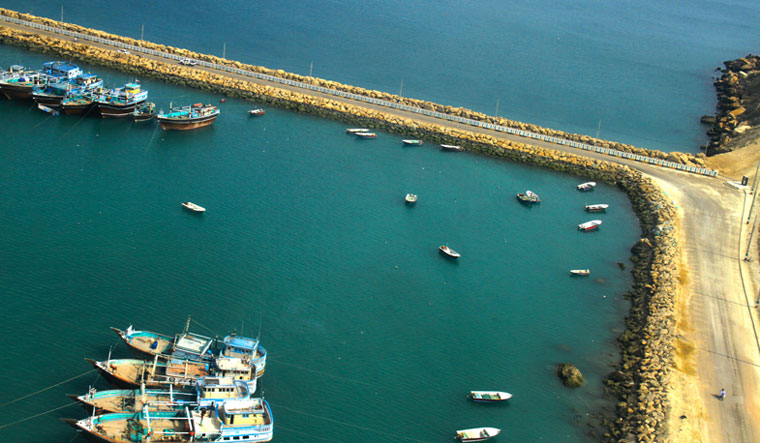“The 6th consignment of 8200 MT wheat carried in 355 containers embarked on its journey from Kandla to Chabahar Port today. So far 45,000 MT wheat out of the total generous gift of 7,5000 MT wheat from India to Afghanistan, has been dispatched home,'' tweeted Tahir Qadiry, Charge d’Affaires, Afghanistan Embassy in India, on Wednesday.
Chabahar is the first port operated by India outside of its territorial boundaries. The port is important for India for several reasons. Strategically located at the Sistan-Balochistan region of Iran, the port is close to the landlocked Afghanistan—around 1,000 km away—and provides an alternate access to the land route, which is through the hostile Pakistani territory. Chabahar is also a gateway to Central Asia, and is envisaged as part of the 7,200km multi-mode International North South Transport Corridor (INSTC) which would give India access to the markets of Central Asia, Russia and right up to Europe. More importantly, it is only 72km away from Gwadar, the port in Pakistan that China is developing as part of the China-Pakistan Economic Corridor (CPEC), and henace seen as a challenger to Gwadar.
While Chabahar could open up large opportunities for trade and connectivity for India, its experience with this port is appearing to be rather limited, and confined mainly to operating one terminal of the vast port. This wasn't what India had envisaged. However, a number of geopolitical developments have curtailed India's vision. Iran's recent decision to develop the 628 km Chabahar-Zahedan railway project without Indian assistance has come as a setback for India. The original plan was for India to develop two terminals and operate five berths at the port on a ten-year lease. India had also got access to the free trade zone in the hinterland of the port and opportunity to build the railway line.
Iran said it will develop the line alone. Iran is part of China's Belt and Road Initiative (BRI) and China, last year, announced an intention of injecting 400 billion dollars into Iran for developing oil, gas and transport infrastructure. Iran claimed that it decided to drop India because of a delay in receiving funding from the latter. The Indian Railway Construction Company (IRCON) was expected to pump 1.6 billion dollars into the project.
The loss of the project is an opportunity lost for India, as the opposition was quick to point out. Congress leader Rahul Gandhi had tweeted: “India's global strategy is in tatters. We are losing power and respect everywhere and GOI has no idea what to do.''
India has had a series of bad luck, or bad timing, when it comes to its Chabahar ambitions. Operations of the first terminal were just about to be handed over to India when US President Donald Trump decided to walk away from the Iran Civil Nuclear Deal and impose sanctions on Iran. The Narendra Modi government, which had made major progress in its relations with the US, even signing strategic deals like COMCASA and LEMOA, was pushed against a wall, with this move. India had little option but to cut its crude oil imports from Iran to zero—Iran was the fourth largest crude supplier to India. Iran was naturally peeved and was seeking out more stable partners. Russia and China have proved to be that.
Using adept diplomacy, India managed to keep Chabahar out of the sanctions. The US, for which the port is beneficial for accessing Afghanistan, agreed. However, the US sanctions have made companies wary of investing in the Foreign-Trade Zones (FTZ). Progress on the FTZ has been slow from the Iran side as well. Only earlier this month did they get the port integrated with the FTZ. This integration should boost cargo through the port. Earlier this month, the port did a record handling of 76 TEU (twenty-foot equivalent unit) of cargo. India has also used the Chabahar route to ship 20,000 litres of Malathion to Iran as part of its outreach to jointly deal with the locust swarm problem this year. However, the Chabahar vision for India is more than just a port. The rail link is an important step to optimise the port.
The China factor is even bigger now. China has been in good terms with all three countries in the region—Iran, Afghanistan and Pakistan, though Afghanistan is not yet in the BRI loop. With a sharp polarising of the world post the pandemic, India's 'hunt with the foxes and run with the hares' approach has limitations. A wariness to invest in the project could only benefit another party. The slow pace of the project benefits no one.
Recently, Afghan president Ashraf Ghani too had urged India and Iran to speed up the rail line to Zahedan, which is close to the Afghan border. It is also reported that China has staked big investments in the FTZ.
Irani officials say the doors are still open for India to join the rail project. Is their announcement to start the project alone, therefore, a prod to India to hurry up with the funding before it misses the train? Iran is well aware that the Indian government has allocated in its annual budget Rs 100 crore for the Chabahar project.
India maintains that it is very much part of the railway project and remains committed to it.



